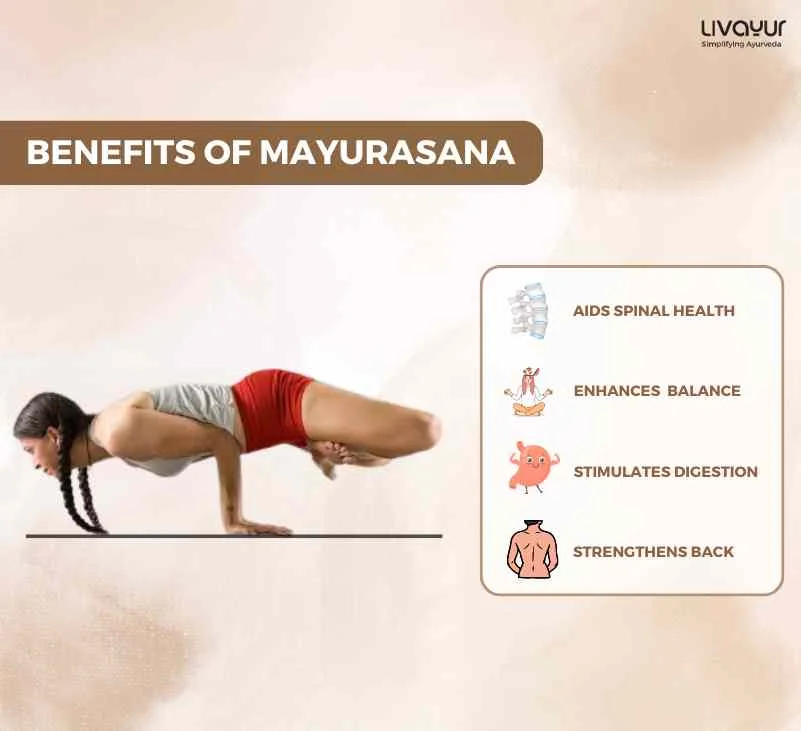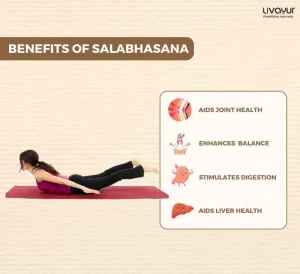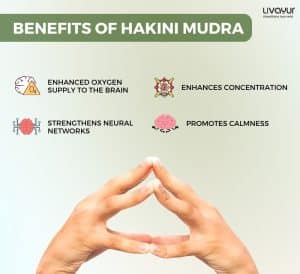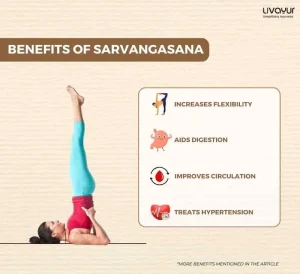This article is reviewed by an expert
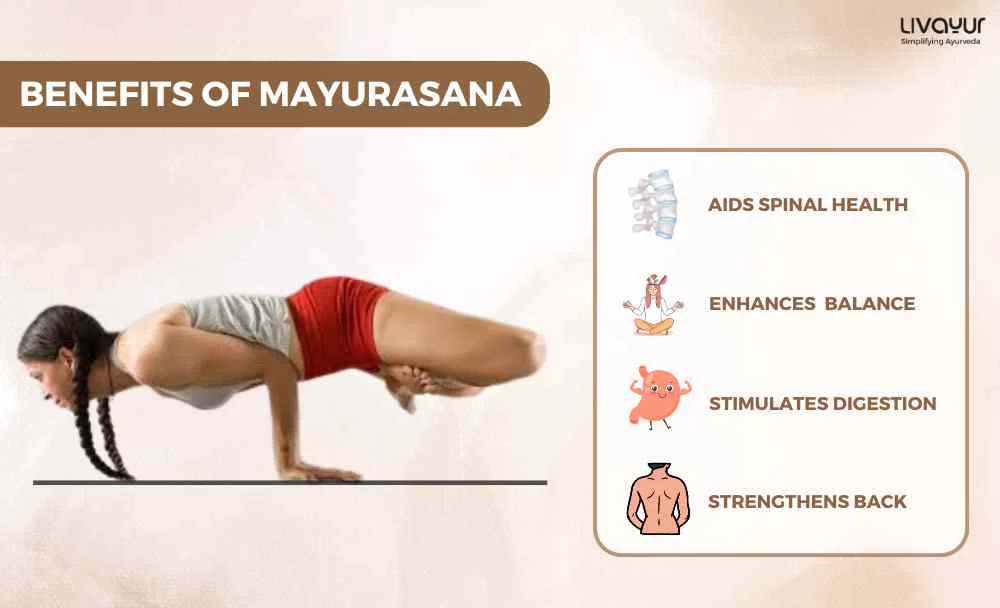
Yoga is one of the best ways to improve posture, strength, balance and flexibility. It is also highly beneficial in improving the health of several internal organs like the digestive system, respiratory system, etc.
One of the most important poses mentioned in the Yogic scriptures is Mayurasana or Peacock Pose.
Let’s find out more about this yoga asana and its many benefits in this article.
What Is Mayurasana (1)?
Mayurasana, also known as the Peacock Pose, is a yoga asana that combines strength, balance, and concentration. The name “Mayurasana” is derived from the Sanskrit words “Mayura,” meaning peacock, and “asana,” meaning posture. This pose is considered one of the 32 most important asanas according to the ancient text Gheranda Samhita.
How To Do Mayurasana (1)?
- Kneel on the floor, ensuring your knees are separated and your feet are together.
- Lean forward and place both palms between your knees on the floor, with your fingers pointing towards your feet.
- Adjust your hand position for comfort and flexibility.
- Bring your elbows and forearms together.
- Lean further forward and rest your abdomen on your elbows while your chest rests on your upper arms.
- Straighten and stretch your legs backwards, keeping them together.
- Engage the muscles of your body and slowly lift your trunk and legs, raising them until they are parallel to the floor.
- Keep your head lifted upward.
- Balance your entire body only on the palms of your hands.
- Gradually elevate your legs and feet higher, maintaining their straightness and adjusting your body’s balance.
- Avoid straining and listen to your body’s limits.
- In the final position, the weight of your body should be supported by the abdominal muscles, not the chest.
- Hold the pose for a short period of time, and then slowly return to the starting position.
Benefits of Mayurasana (1)
Upper Body Strength and Stability
Primary Benefits: Mayurasana improves shoulder mobility, strengthens the rotator cuff muscles, and enhances upper body strength. In addition, it also helps improve scapular stability and strength, promoting better shoulder mechanics and posture.
Secondary Benefits: Mayurasana also strengthens the arm muscles, including the biceps and forearms, and increases flexibility and strength in the wrists, enhancing overall upper body strength.
Spinal Stability and Strength
Primary Benefits: Mayurasana engages the muscles responsible for cervical extension, thoracic flexion, and lumbar extension, promoting spinal stability and strength.
Secondary Benefits: As a result, Mayurasana helps improve body posture and strength and reduce the risk of spinal injuries.
Lower Body Stability and Flexibility
Primary Benefits: Mayurasna activates the hip muscles, including the gluteus maximus, adductors, and medial rotators, enhancing hip strength, stability, and flexibility. It also strengthens the quadriceps muscles and stabilises the knee joint, improving lower body stability.
Secondary Benefits: Furthermore, Mayurasana targets the muscles of the posterior compartment of the leg, intrinsic and extrinsic muscles of the toe joint, and adductors of the toes, promoting strength and flexibility in the lower legs and feet.
Digestive system
Primary Benefits: Mayurasana helps improve digestion and relieve abdominal disorders by alleviating discomfort and promoting a healthier abdominal region.
Secondary Benefits: In addition, Mayurasana also helps enhance the appetite and promote overall digestive health.
The Takeaway
Mayurasana, or the Peacock Pose, is a powerful yoga asana that offers a multitude of benefits for both physical and internal well-being. This pose requires strength, balance, and concentration, making it a transformative practice.
By regularly practising Mayurasana, you can experience improvements in upper body strength and stability, spinal stability and strength as well as lower body stability and flexibility. Additionally, Mayurasana also aids in improving digestion and relieving abdominal disorders, creating a healthier digestive system.
FAQs
- Is Mayurasana suitable for beginners?
Mayurasana is an advanced yoga pose that requires strength and flexibility. It is recommended to have some experience with yoga before attempting this pose and take the help of an experienced yoga practitioner to learn it properly.
- What are some tips for maintaining balance in Mayurasana?
To maintain balance in Mayurasana, focus on engaging your core muscles and distributing your weight evenly on your palms. Keep your gaze fixed on a point in front of you and practise with patience and persistence.
- Can Mayurasana help with back pain?
Mayurasana can help strengthen the muscles of the back and improve spinal stability, which may contribute to reducing back pain. However, it is important to consult with a qualified yoga instructor or healthcare professional before attempting this pose if you have a history of back pain or injuries.
- How long should I hold Mayurasana?
As a challenging pose, it is recommended to start with a few seconds and gradually increase the duration as your strength and balance improve. Aim for holding the pose for about 10-20 seconds initially and then gradually extend the time based on your comfort level.
Disclaimer: This article is written from a health and lifestyle perspective. It is for general information and not meant to substitute any medical advice. Please consult your doctor for appropriate medical consultation.




